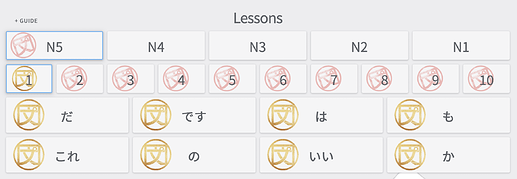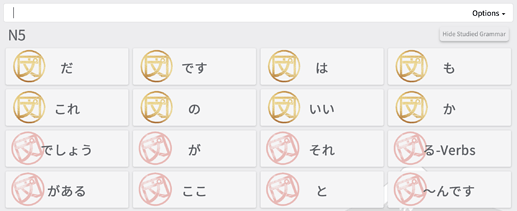@Kai Hey! You are correct about に in that it cannot work here. I think that the confusion might come from the verb “届ける” given as a hint. 明日のお届け is basically functioning as a noun here (“tomorrow’s delivery”), so the sentence would be more literally translated as “it will become tomorrow’s delivery.” Cheers!
Someone on reddit has a question about a 文プロ sentence, maybe someone here can help them out better. It seems to me like a sentence that was written for ものか, then re-used for ものだ while accidentally keeping its ものか translation…
Or, maybe I need to brush up on all the uses for もの 
Copy/paste:
よくあんな男とデート出来るものだ。explanation?
According to bunpro website ものだ is used as a sentence ender for
supposed to, should, that’s the way it is
so why does it translate to : How could you date that kind of guy!
Thanks in advance for any help here!
@Kai This sentence does not appear on Bunpro. I think that the poster was just referring to the meanings listed on Bunpro when trying to decipher this sentence. You can use ものだ to express deep emotion, however using ものだ to express “should,” “supposed to,” or “that’s just the way it is” is much more common. We will update ものだ to include this information. Cheers!
Would it be possible to have an option to display “All Grammar” the same way it’s displayed on the bookmarked grammar page (where we can see both Japanese and English without a need of hovering the mouse over the grammar point)? And maybe also bookmarking/unbookmarking grammar directly on that page.
Do I get different sentences for the same grammar point between reviews? How do Ghost Reviews influence this?
Choose Ghost Review Aggressiveness
- When Ghost Reviews are set to ‘ ON ’ in settings, a Ghost Review will be created for a sentence if you miss it once in your reviews. Set Ghost Reviews to ‘ Minimal ’ to only add a sentence to Ghost Reviews if you miss the same sentence more than once.
You don’t go backwards on the SRS scale like other systems for wrong answers but the ghost review will require a number of correct answers before clearing as a separate SRS count. Generally I think it works well because I’d like have additional exposure to a grammar point rather than be tied to a specific sentence that I can’t seem to grasp. Plus it’s easy to start memorizing the content of sentence for the answer (rather than the grammar point) so I think this works to help mitigate this issue as well. I keep mine on minimal.
I am currently at the end of a yearly plan, with autorenewal off. I decided I want to switch to a monthly plan now, but it won’t let me switch to it and says “please wait at the end of your current subscription”. A bit annoying it’ll probably mess my review times especially if it happens at night, and then furthermore have to wait if the sub doesn’t go through immediately. I’m assuming I won’t lose my SRS reviews if I have a period of no subscription, though?
Hey and long time no see! 
You won’t lose your SRS data! So no worries!
I will pass this to the technical part of the team!
Cheers!
A follow up question, if I may. I’m taking a break with Bunpro as I’m focusing more on reading ATM. My subscription ended, and as expected I can’t do any reviews anymore. Are my SRS automatically in vacation mode now? The button seems to be hidden from non-subscribers. It would be quite problematic to come back sometime and find hundreds of reviews 
Thanks!
@sandalwood Hey! I apologize for the late reply. If you become unsubscribed your reviews will be frozen. If/when you should choose to resubscribe, Bunpro will bump your reviews to the state they would have been in at the end of your subscription, so basically vacation mode. Cheers!
It would be nice to have furigana for kanji that shows up in the answer space too, like here.
I’m way ahead with grammar, but I’m a baby when it comes to kanji and I linked my Wanikani account to Bunpro, but it still doesn’t show me furigana for words that show up like this.
I hope in the future, we can have Japanese hints as an option for a full immersion experience. This one can be done backward from N1 to N3; N4 and N5 are probably not necessary. I feel like starting from N2 onwards, English hints start to feel like a hindrance to our thinking instead of being helpful. I genuinely think Japanese explanations are easier to understand by that point.
I’m going to have a little whinge here, but… I have reached the point where some grammar points are getting their gold stamp and I had expected there might be some animation or other during the Study session, but nope. I only found out I’d finished the grammar points by accident when I happened across them in search! Please give us some confetti or something 
Oh please tell me the stamps go gold in the lessons view?!!!
I was a bit disappointed that they didn’t change colour depending on their SRS but if they go gold eventually, that’s pretty cool.
I quadruple this.
In general the site could use some more game feel. More chimes, level up animations, Gold stamp animations, etc.
One thing I liked about Duolingo is that chime when you get something correct. It really makes you want to rack up some points! 
Wasn’t sure where to put this or if this was mentioned, but the Genki 1 deck for the 3rd edition uses some different vocab/kanji with the same sounds, which I can see is an easy mistake. So far what I see should be changed is:
あつい = 厚い[thick] change to 暑い[hot]
せんたく= 選択[selection] change to 洗濯[washing]
はる=張る[paste] change to 春[spring]
Thanks a lot for these decks, this helps a lot with my studies.
Phrasing - Sometimes when entering an answer that is similar to what is correct, but not right, the yellow text that appears can sometimes be unclear. When you use the word “this grammar point” followed by explanations, it can sometimes be unclear if you are referring to my grammar point or the one you want me to enter. I usually assume it is the answer grammar point you are referring to.
It’s a bit of a nitpick, but it would help if you used more specific phrasings as “what you wrote”, “the answer we are looking for” etc.
It would also clear up some explanations where you are comparing two synonymous grammar points as it also can be a bit fuzzy as to which one you are referring to at times.
I do not have any concrete examples at hand but maybe you understand what I’m trying to get at.
I’ll try to update if I find any good examples.



